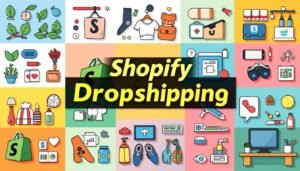Starting a dropshipping store on Shopify is easy. It’s great for both new and old businesses. Shopify’s tools and apps make managing inventory simple. This lets you focus on selling and growing your brand.
There are three ways to start dropshipping on Shopify. You can use an automated app, work directly with a supplier, or add products to your line with Shopify Collective. Picking the best method and facing challenges will shape your journey. It will also decide how successful you’ll be.
Key Takeaways
- Shopify offers a streamlined platform for launching a successful dropshipping business.
- Automated dropshipping apps, direct supplier partnerships, and Shopify Collective provide flexible options for sourcing and managing products.
- Navigating the unique challenges of dropshipping, such as product sourcing and inventory control, is crucial for long-term success.
- Optimizing your store’s design, product listings, and marketing strategies can help you stand out in a competitive dropshipping market.
- Leveraging Shopify’s powerful tools and apps can automate and streamline various aspects of your dropshipping operations.
Understanding Dropshipping on Shopify
Dropshipping lets you start an online store without keeping products in stock. When someone orders, you send the order to the supplier. They then ship it to the customer. This makes starting an online store easy and appealing.
What is Dropshipping?
Dropshipping means you don’t keep products in stock. When someone orders, the supplier ships it directly. This way, starting an online store is cheap and easy.
Benefits of Dropshipping on Shopify
- No need to manage inventory: You don’t have to buy, store, or ship products. The supplier does it all.
- Lower startup costs: Starting a dropshipping business costs very little. It’s great for those new to online business.
- Ability to sell a wide range of products: Suppliers offer many products. You can pick from a huge selection without buying in bulk.
- Flexibility to experiment with different products and niches: Dropshipping lets you try new products and change what you sell based on what customers want.
Dropshipping on Shopify lets you focus on marketing and growing your brand. Shopify’s platform makes it easy to start a store with little money. You can try out different products and see what works best.
“Dropshipping contributes to over $300 billion in ecommerce sales annually, making it a lucrative business model for entrepreneurs looking to start their own online store.”
Setting Up Your Shopify Dropshipping Store
Starting a Shopify dropshipping business starts with a Shopify account. Shopify gives a free trial to help you set up fast. After your account, pick a niche and name for your store.
Creating a Shopify Account
Shopify powers over four million websites. It’s a great choice for starting an e-commerce business. They have plans like Starter ($5/month), Basic ($39/month), and Retail ($89/month).
Transaction fees with Shopify Payments vary. They are 2.9% plus $0.30 to 5% plus $0.30, based on your plan.
Choosing a Niche and Store Name
Choosing a niche helps you find your customer base. Pick a store name that’s memorable and fits your niche. Use tools like keyword research and business name generators for ideas.
Registering a custom domain name, like a ‘.com’ from Namecheap for $5.98/year, makes your store look professional.
Doing market research is key. Use tools like Semrush and Google Trends to find your audience and popular products.

With a Shopify account and a niche and name picked, you’re ready to start. The setup costs are about $300–$400. Monthly costs should be at least $40, not counting fees.
Finding and Selecting Dropshipping Suppliers
Choosing the right dropshipping suppliers is key for your Shopify store’s success. Look at product quality, shipping times, and customer support. Suppliers near your customers mean faster delivery and happier customers.
Criteria for Evaluating Suppliers
To make a great product catalog, focus on these important points:
- Product Quality: Check sample products to see their quality and condition.
- Shipping Times: Choose suppliers who ship fast, in 1-3 days for local orders.
- Inventory Reliability: Find suppliers who keep their inventory right and ship orders on time.
- Customer Support: See if the supplier is quick to help with customer problems.
Popular Dropshipping Supplier Directories
Use online directories like DSers, Spocket, and Modalyst to find suppliers. These sites connect you with trusted dropshipping providers. They also help with tasks like inventory updates and order forwarding.

By doing your homework and picking reliable suppliers, you can make your Shopify store strong. This way, your customers will have a great shopping experience.
Curating Your Product Catalog
Choosing the right products is key for a successful Shopify dropshipping business. Look for items that are in demand and offer something special. Use tools to find out what people are searching for online.
Check out what other stores are selling to find unique items. This helps you stand out in your niche.
When picking products, think about how much profit you can make. Look for items with good profit margins. For example, leggings can be sold for more than double their cost.
Having a unique product catalog makes your store special. Use tools to learn about your customers’ interests. This helps you pick items they will love.

By selecting profitable products, sourcing trending items, and using smart product research strategies, you can grow a successful Shopify dropshipping business. It will attract customers and beat the competition.
Optimizing Product Listings
Making your product pages great is key to selling more on your Shopify store. Start by writing engaging, SEO-friendly descriptions. These should show off what makes each item special. Use words people might search for, but don’t just copy what the supplier says.
Shopify’s AI tools can help make your product copy better. They make it fit what your customers want to see.
Enhancing Product Images
Good descriptions are just the start. Use Shopify’s AI tools to make the product images better. Turn plain images into something that looks great and shows off your brand.

“The global dropshipping market is expected to grow at a rate of 22.8% annually until 2030.”
By making your product listings better with compelling descriptions and appealing imagery, you can sell more. This is a big part of making your dropshipping business successful.
| Optimization Strategy | Benefits |
|---|---|
| Writing SEO-friendly product descriptions | Increased visibility and discoverability in search engine results |
| Using AI-powered imaging tools | Visually distinctive and branded product imagery |
Pricing and Profit Margins
Finding the right price for your dropshipped products is key to making money. As a new dropshipper, you must know all your costs. This includes what you pay for the product, shipping, and other expenses.
After knowing your costs, you can set prices that make you money. You want to make a good profit but also be competitive.
Calculating Costs and Setting Prices
When setting prices for dropshipping, think about a few things. For cheap items, like those under $10, adding a fixed amount to the cost works well. This is called Fixed Markup on Cost.
For items priced between $10 and $30, use Cost-Based Pricing. This means setting the price based on what it costs to make and sell the item. Offering a bundle of related items at a lower price is also smart.
For expensive items, use Perceived Value Pricing. This means setting the price based on what the customer thinks the item is worth.
It’s important to check what others are charging. You want to be affordable but still make a profit. Dropshipping can make 15-25% profit, but it can be more in some cases.
Always check and change your prices to keep making money. Knowing terms like Cost of Goods Sold (COGS) helps you figure out your profit better.

Marketing and Promoting Your Dropshipping Store
To make your Shopify dropshipping business a hit, you need a smart marketing plan. Use social media and SEO to get your store seen by more people. This will help you get more visitors and sell more.
Social Media Marketing Strategies
Facebook, Instagram, and TikTok are great for talking to your customers and making your brand known. Make your posts look good, use ads to target people, and work with influencers. This way, you can show off your products to more people.
Keep your social media fresh with fun stuff. This will help you get more followers and more people visiting your store.
Search Engine Optimization (SEO) Tactics
Getting your Shopify store to show up in search results is key. Use the right keywords in your product pages, write helpful blog posts, and get links from other sites. Good SEO means more people can find your store.
Using social media and SEO together can really help your business grow. These strategies help you find and sell to more people, making your online store a success.
| Social Media Marketing Tactics | SEO Strategies |
|---|---|
|
|
Automating and Streamlining Operations
As your Shopify dropshipping business grows, it’s key to automate and streamline. Use dropshipping automation tools like DSers, Spocket, and AutoDS. They handle tasks like finding products, syncing inventory, and processing orders on their own.
These apps connect your store to trusted suppliers. This lets you add more products and fulfill orders without doing it all by hand.
Automation tools save you time. You can then focus on business strategy, marketing, and growing your business. Shopify has over 8,000 apps, including many for dropshipping and making your business run smoother.
With automation, you can grow your business, make customers happier, and succeed in the competitive Shopify dropshipping world.
FAQ
What is dropshipping and how does it work on Shopify?
Dropshipping is a way to sell products online without keeping them in stock. When someone buys something, the supplier ships it directly to them. This means you can start a store with little money and no big upfront costs. Shopify makes it easy to manage this and focus on selling and marketing.
What are the key benefits of dropshipping on Shopify?
Dropshipping on Shopify has many benefits. You don’t have to worry about inventory, it’s cheap to start, and you can sell lots of products. It lets you focus on marketing and growing your brand, not just on getting products to customers.
How do I set up a Shopify dropshipping store?
First, make a Shopify account and pick a niche and name for your store. Picking a niche helps you find the right products for your customers. Also, get a custom domain name to look more professional online.
How do I find reliable dropshipping suppliers for my Shopify store?
Finding good suppliers is key. Look at product quality, shipping times, and customer support. Use sites like DSers, Spocket, and Modalyst to find trusted suppliers for your Shopify store.
What should I look for when selecting products to sell on my Shopify dropshipping store?
Look for trending items that solve problems or impress customers. Use tools to find what people are searching for. Also, check what others are selling to find unique products for your store.
How do I optimize product pages to drive sales on my Shopify dropshipping store?
Make your product pages great. Write good descriptions that highlight what’s special about each item. Use the right keywords and make the images look good with Shopify’s tools.
How do I price my dropshipped products to maintain profitability?
First, figure out all your costs, like what you pay for the product and shipping. Then, set prices that make you money but are still good for customers. Check your prices often to keep making money and keep customers happy.
What marketing strategies can I use to promote my Shopify dropshipping store?
Good marketing is important. Use social media to talk to your customers. Make cool content, run ads, and work with influencers. Also, make your store easy to find online by using the right keywords and creating useful blog posts.
How can I automate and streamline my Shopify dropshipping operations?
As you grow, make things easier by automating tasks. Use apps like DSers, Spocket, and AutoDS to handle finding products and shipping. These apps connect you to suppliers, so you can sell more without doing everything yourself.







